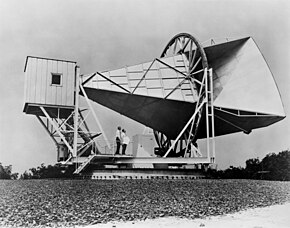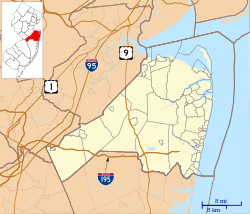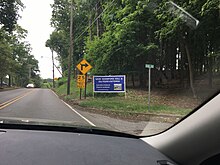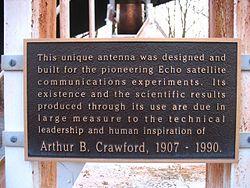
The cosmic microwave background is microwave radiation that fills all space in the observable universe. It is a remnant that provides an important source of data on the primordial universe. With a standard optical telescope, the background space between stars and galaxies is almost completely dark. However, a sufficiently sensitive radio telescope detects a faint background glow that is almost uniform and is not associated with any star, galaxy, or other object. This glow is strongest in the microwave region of the radio spectrum. The accidental discovery of the CMB in 1965 by American radio astronomers Arno Penzias and Robert Wilson was the culmination of work initiated in the 1940s.
Cosmic noise, also known as galactic radio noise, is not actually sound, but a physical phenomenon derived from outside of the Earth's atmosphere. It can be detected through a radio receiver, which is an electronic device that receives radio waves and converts the information given by them to an audible form. Its characteristics are comparable to those of thermal noise. Cosmic noise occurs at frequencies above about 15 MHz when highly directional antennas are pointed toward the Sun or other regions of the sky, such as the center of the Milky Way Galaxy. Celestial objects like quasars, which are super dense objects far from Earth, emit electromagnetic waves in their full spectrum, including radio waves. The fall of a meteorite can also be heard through a radio receiver; the falling object burns from friction with the Earth's atmosphere, ionizing surrounding gases and producing radio waves. Cosmic microwave background radiation (CMBR) from outer space is also a form of cosmic noise. CMBR is thought to be a relic of the Big Bang, and pervades the space almost homogeneously over the entire celestial sphere. The bandwidth of the CMBR is wide, though the peak is in the microwave range.

A radio telescope is a specialized antenna and radio receiver used to detect radio waves from astronomical radio sources in the sky. Radio telescopes are the main observing instrument used in radio astronomy, which studies the radio frequency portion of the electromagnetic spectrum emitted by astronomical objects, just as optical telescopes are the main observing instrument used in traditional optical astronomy which studies the light wave portion of the spectrum coming from astronomical objects. Unlike optical telescopes, radio telescopes can be used in the daytime as well as at night.

Radio astronomy is a subfield of astronomy that studies celestial objects at radio frequencies. The first detection of radio waves from an astronomical object was in 1933, when Karl Jansky at Bell Telephone Laboratories reported radiation coming from the Milky Way. Subsequent observations have identified a number of different sources of radio emission. These include stars and galaxies, as well as entirely new classes of objects, such as radio galaxies, quasars, pulsars, and masers. The discovery of the cosmic microwave background radiation, regarded as evidence for the Big Bang theory, was made through radio astronomy.
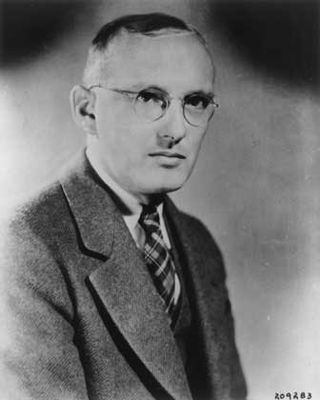
Karl Guthe Jansky was an American physicist and radio engineer who in April 1933 first announced his discovery of radio waves emanating from the Milky Way in the constellation Sagittarius. He is considered one of the founding figures of radio astronomy.

Robert Woodrow Wilson is an American astronomer who, along with Arno Allan Penzias, discovered cosmic microwave background radiation (CMB) in 1964. The pair won the 1978 Nobel Prize in Physics for its discovery.

Arno Allan Penzias was an American physicist and radio astronomer. Along with Robert Woodrow Wilson, he discovered the cosmic microwave background radiation, for which he shared the Nobel Prize in Physics in 1978.

A directional antenna or beam antenna is an antenna which radiates or receives greater radio wave power in specific directions. Directional antennas can radiate radio waves in beams, when greater concentration of radiation in a certain direction is desired, or in receiving antennas receive radio waves from one specific direction only. This can increase the power transmitted to receivers in that direction, or reduce interference from unwanted sources. This contrasts with omnidirectional antennas such as dipole antennas which radiate radio waves over a wide angle, or receive from a wide angle.

The Dominion Astrophysical Observatory, located on Observatory Hill, in Saanich, British Columbia, was completed in 1918 by the Canadian government. The Dominion architect responsible for the building was Edgar Lewis Horwood. The main instrument is the 72-inch-aperture (1.83 m) Plaskett telescope, proposed and designed by John S. Plaskett in 1910 with the support of the International Union for Cooperation in Solar Research.
The discovery of cosmic microwave background radiation constitutes a major development in modern physical cosmology. In 1964, US physicist Arno Allan Penzias and radio-astronomer Robert Woodrow Wilson discovered the cosmic microwave background (CMB), estimating its temperature as 3.5 K, as they experimented with the Holmdel Horn Antenna. The new measurements were accepted as important evidence for a hot early Universe and as evidence against the rival steady state theory as theoretical work around 1950 showed the need for a CMB for consistency with the simplest relativistic universe models. In 1978, Penzias and Wilson were awarded the Nobel Prize for Physics for their joint measurement. There had been a prior measurement of the cosmic background radiation (CMB) by Andrew McKellar in 1941 at an effective temperature of 2.3 K using CN stellar absorption lines observed by W. S. Adams. Although no reference to the CMB is made by McKellar, it was not until much later after the Penzias and Wilson measurements that the significance of this measurement was understood.
Observational cosmology is the study of the structure, the evolution and the origin of the universe through observation, using instruments such as telescopes and cosmic ray detectors.

Project Echo was the first passive communications satellite experiment. Each of the two American spacecraft, launched in 1960 and 1964, were metalized balloon satellites acting as passive reflectors of microwave signals. Communication signals were transmitted from one location on Earth and bounced off the surface of the satellite to another Earth location.

A horn antenna or microwave horn is an antenna that consists of a flaring metal waveguide shaped like a horn to direct radio waves in a beam. Horns are widely used as antennas at UHF and microwave frequencies, above 300 MHz. They are used as feed antennas for larger antenna structures such as parabolic antennas, as standard calibration antennas to measure the gain of other antennas, and as directive antennas for such devices as radar guns, automatic door openers, and microwave radiometers. Their advantages are moderate directivity, broad bandwidth, low losses, and simple construction and adjustment.

Crawford Hill, sometimes known in the past as Crawford's Hill, is located in Holmdel Township, New Jersey, United States. It is Monmouth County's highest point, as well as the highest point in New Jersey's coastal plain, standing 391 feet (119 m) above sea level. The hill is best known as the site of a Bell Telephone Laboratories facility that was an annexto the Bell Labs Holmdel Complex located three miles away. The 43-acre annex property is comprised of a main research building and a number of other structures and scientific instruments, among them the historic Holmdel Horn Antenna.

The Dominion Radio Astrophysical Observatory is a research facility founded in 1960 and located at Kaleden, British Columbia, Canada. The site houses four radio telescopes: an interferometric radio telescope, a 26-m single-dish antenna, a solar flux monitor, and the Canadian Hydrogen Intensity Mapping Experiment (CHIME) — as well as support engineering laboratories. The DRAO is operated by the Herzberg Institute of Astrophysics of the National Research Council of the Government of Canada. The observatory was named an IEEE Milestone for first radio astronomical observations using VLBI.
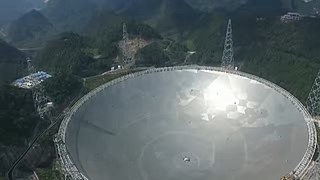
The Five-hundred-meter Aperture Spherical Telescope, nicknamed Tianyan, is a radio telescope located in the Dawodang depression (大窝凼洼地), a natural basin in Pingtang County, Guizhou, southwest China. FAST has a 500 m (1,600 ft) diameter dish constructed in a natural depression in the landscape. It is the world's largest filled-aperture radio telescope and the second-largest single-dish aperture, after the sparsely-filled RATAN-600 in Russia.
Harald Trap Friis, who published as H. T. Friis, was a Danish-American radio engineer whose work at Bell Laboratories included pioneering contributions to radio propagation, radio astronomy, and radar. His two Friis formulas remain widely used.

The Bell Labs Holmdel Complex, in Holmdel Township, Monmouth County, New Jersey, United States of America, functioned for 44 years as a research and development facility, initially for the Bell System and later Bell Labs. The centerpiece of the campus is an Eero Saarinen–designed structure that served as the home to over 6,000 engineers and researchers. This modernist building, dubbed "The Biggest Mirror Ever" by Architectural Forum, due to its mirror box exterior, was the site of a Nobel Prize discovery, the laser cooling work of Steven Chu.
Bell Telephone Laboratories may refer to:

The Lunar Crater Radio Telescope (LCRT) is a proposal by the NASA Institute for Advanced Concepts (NIAC) to create an ultra-long-wavelength radio telescope inside a lunar crater on the far side of the Moon.
